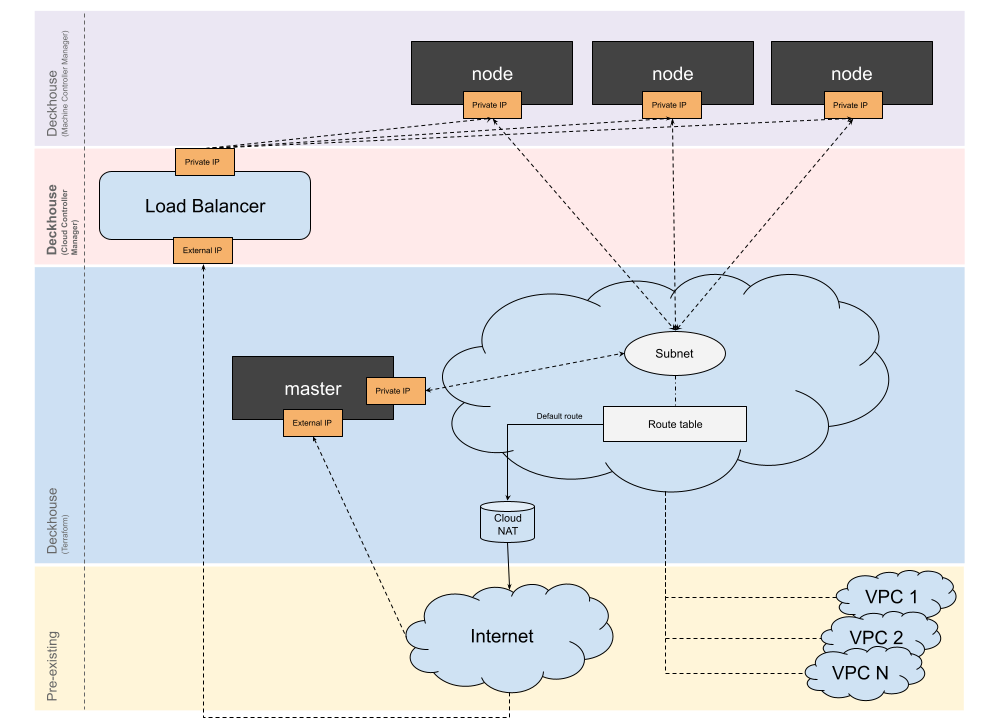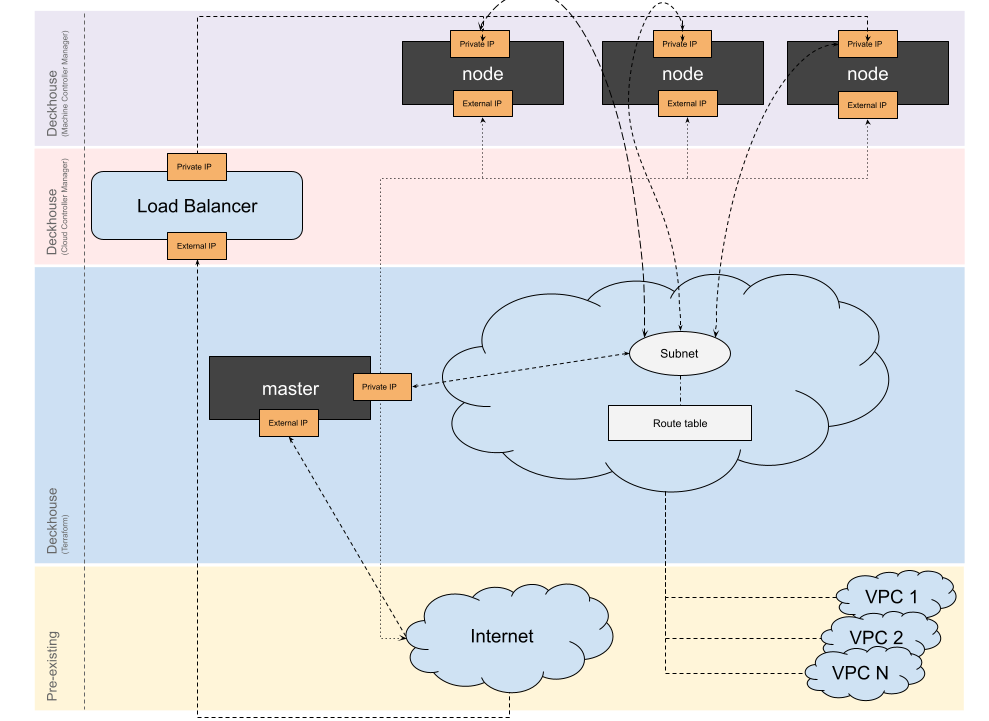Layouts
This section describes the possible node placement layouts in Google Cloud Platform (GCP) infrastructure and the related configuration options. The selected layout affects networking behavior, availability of public IP addresses, outgoing traffic routing, and how nodes are accessed.
Deckhouse Kubernetes Platform (DKP) supports two layouts for deploying resources in GCP.
Standard
- A dedicated VPC is created for the cluster along with Cloud NAT.
- Cluster nodes do not have public IP addresses by default.
- Public IP addresses can be assigned to static and master nodes:
- In this case, One-to-One NAT is used to map the public IP address to the node’s internal IP address (Cloud NAT will not be used in this scenario).
- If the master node does not have a public IP address, an additional instance with a public IP address (for example, a bastion host) is required for cluster installation and access.
- Peering can be configured between the cluster’s VPC and other VPCs.

Example layout configuration:
apiVersion: deckhouse.io/v1
kind: GCPClusterConfiguration
layout: Standard
standard:
# Optional. Listed addresses will be used for
# addressing Cloud NAT.
cloudNATAddresses:
- example-address-1
- example-address-2
subnetworkCIDR: 10.0.0.0/24 # Required.
# Optional. A list of GCP VPC Networks used by Kubernetes VPC
# Network to connect over peering.
peeredVPCs:
- default
sshKey: "<SSH_PUBLIC_KEY>" # Required.
labels:
kube: example
masterNodeGroup:
replicas: 1
zones: # Optional.
- europe-west4-b
instanceClass:
machineType: n1-standard-4 # Required.
image: projects/ubuntu-os-cloud/global/images/ubuntu-2404-noble-amd64-v20250313 # Required.
diskSizeGb: 20 # Optional. A local disk is used if not set.
disableExternalIP: false # Optional. The master node has externalIP by default.
additionalNetworkTags: # Optional.
- tag1
additionalLabels: # Optional.
kube-node: master
nodeGroups:
- name: static
replicas: 1
zones: # Optional.
- europe-west4-b
instanceClass:
machineType: n1-standard-4 # Required.
image: projects/ubuntu-os-cloud/global/images/ubuntu-2404-noble-amd64-v20250313 # Required.
diskSizeGb: 20 # Optional. A local disk is used if not set.
disableExternalIP: true # Optional. The nodes don't have externalIP by default.
additionalNetworkTags: # Optional.
- tag1
additionalLabels: # Optional.
kube-node: static
provider:
region: europe-west4 # Required.
serviceAccountJSON: | # Required.
{
"type": "service_account",
"project_id": "sandbox",
"private_key_id": "98sdcj5e8c7asd98j4j3n9csakn",
"private_key": "-----BEGIN PRIVATE KEY-----",
"client_id": "342975658279248",
"auth_uri": "https://accounts.google.com/o/oauth2/auth",
"token_uri": "https://oauth2.googleapis.com/token",
"auth_provider_x509_cert_url": "https://www.googleapis.com/oauth2/v1/certs",
"client_x509_cert_url": "https://www.googleapis.com/robot/v1/metadata/x509/k8s-test%40sandbox.iam.gserviceaccount.com"
}
WithoutNAT
- A dedicated VPC is created for the cluster. All cluster nodes are assigned public IP addresses.
- Peering can be configured between the cluster’s VPC and other VPCs.

Example layout configuration:
apiVersion: deckhouse.io/v1
kind: GCPClusterConfiguration
layout: WithoutNAT
subnetworkCIDR: 10.0.0.0/24 # Required.
# Optional. A list of GCP VPC Networks used by Kubernetes VPC
# Network to connect over peering.
peeredVPCs:
- default
labels:
kube: example
masterNodeGroup:
replicas: 1
zones: # Optional.
- europe-west4-b
instanceClass:
machineType: n1-standard-4 # Required.
image: projects/ubuntu-os-cloud/global/images/ubuntu-2404-noble-amd64-v20250313 # Required.
diskSizeGb: 20 # Optional. A local disk is used if not set.
additionalNetworkTags: # Optional.
- tag1
additionalLabels: # Optional.
kube-node: master
nodeGroups:
- name: static
replicas: 1
zones: # Optional.
- europe-west4-b
instanceClass:
machineType: n1-standard-4 # Required.
image: projects/ubuntu-os-cloud/global/images/ubuntu-2404-noble-amd64-v20250313 # Required.
diskSizeGb: 20 # Optional. A local disk is used if not set.
additionalNetworkTags: # Optional.
- tag1
additionalLabels: # Optional.
kube-node: static
provider:
region: europe-west4 # Required.
serviceAccountJSON: | # Required.
{
"type": "service_account",
"project_id": "sandbox",
"private_key_id": "98sdcj5e8c7asd98j4j3n9csakn",
"private_key": "-----BEGIN PRIVATE KEY-----",
"client_id": "342975658279248",
"auth_uri": "https://accounts.google.com/o/oauth2/auth",
"token_uri": "https://oauth2.googleapis.com/token",
"auth_provider_x509_cert_url": "https://www.googleapis.com/oauth2/v1/certs",
"client_x509_cert_url": "https://www.googleapis.com/robot/v1/metadata/x509/k8s-test%40sandbox.iam.gserviceaccount.com"
}
Configuration
Integration with GCP is handled via the GCPClusterConfiguration resource, which describes the cloud cluster configuration in GCP and is used by the cloud provider when the control plane is hosted in the cloud. The responsible DKP module configures itself automatically based on the selected layout.
To update the configuration of a running cluster, run the following command:
d8 system edit provider-cluster-configuration
After modifying node-related parameters, you must run the dhctl converge command for the changes to take effect.
Example configuration:
apiVersion: deckhouse.io/v1
kind: GCPClusterConfiguration
layout: WithoutNAT
sshKey: "<SSH_PUBLIC_KEY>"
subnetworkCIDR: 10.36.0.0/24
masterNodeGroup:
replicas: 1
zones:
- europe-west3-b
instanceClass:
machineType: n1-standard-4
image: projects/ubuntu-os-cloud/global/images/ubuntu-2404-noble-amd64-v20240523a
diskSizeGb: 50
nodeGroups:
- name: static
replicas: 1
zones:
- europe-west3-b
instanceClass:
machineType: n1-standard-4
image: projects/ubuntu-os-cloud/global/images/ubuntu-2404-noble-amd64-v20240523a
diskSizeGb: 50
additionalNetworkTags:
- tag1
additionalLabels:
kube-node: static
provider:
region: europe-west3
serviceAccountJSON: "<SERVICE_ACCOUNT_JSON>"
Machine provisioning and parameters are configured in the NodeGroup custom resource,
where the instance class for the node group is specified (the cloudInstances.classReference parameter).
For GCP, the instance class is a GCPInstanceClass custom resource that defines the machine parameters.
DKP also automatically creates StorageClasses that cover all available disk types in GCP:
| Disk type | Replication | StorageClass name |
|---|---|---|
| standard | none | pd-standard-not-replicated |
| standard | regional | pd-standard-replicated |
| balanced | none | pd-balanced-not-replicated |
| balanced | regional | pd-balanced-replicated |
| ssd | none | pd-ssd-not-replicated |
| ssd | regional | pd-ssd-replicated |
You can exclude unnecessary StorageClasses by specifying them in the exclude parameter.
Configuring node security policies
You may need to restrict or allow incoming and outgoing traffic on GCP virtual machines for various reasons:
- Allowing access to cluster nodes from VMs in other subnets.
- Allowing access to static node ports for an application.
- Restricting access to external resources or other VMs in the cloud following the requirements of the security team.
To implement this, use additional network tags.
Setting additional network tags for static and master nodes
This parameter can be set during cluster creation or in an existing cluster. In both cases, the additional network tags must be specified in GCPClusterConfiguration:
- For master nodes: Under the
additionalNetworkTagsfield of themasterNodeGroupsection. - For static nodes: Under the
additionalNetworkTagsfield of thenodeGroupssection for the corresponding node group.
The additionalNetworkTags field is an array of strings with network tag names.
Setting additional network tags for ephemeral nodes
Specify the additionalNetworkTags parameter in each GCPInstanceClass resource in the cluster that requires extra network tags.
Adding CloudStatic nodes to the cluster
To add manually created virtual machines to the cluster as nodes, add a Network Tag matching the cluster prefix.
You can find the cluster prefix by running the following command:
kubectl -n kube-system get secret d8-cluster-configuration -o json | jq -r '.data."cluster-configuration.yaml"' \
| base64 -d | grep prefix